Your What is the pathophysiology of an acute attack of extrinsic asthma images are available. What is the pathophysiology of an acute attack of extrinsic asthma are a topic that is being searched for and liked by netizens today. You can Find and Download the What is the pathophysiology of an acute attack of extrinsic asthma files here. Get all royalty-free vectors.
If you’re searching for what is the pathophysiology of an acute attack of extrinsic asthma images information related to the what is the pathophysiology of an acute attack of extrinsic asthma interest, you have come to the right site. Our website always provides you with hints for refferencing the highest quality video and picture content, please kindly hunt and locate more informative video articles and graphics that match your interests.
What Is The Pathophysiology Of An Acute Attack Of Extrinsic Asthma. The exacerbations are mostly caused by an exposure to an allergen. This section presents a definition of asthma a description of the processes on which that definition is basedthe pathophysiology and. There is a confluence of histopatholog-ical changes seen from the gene-environment interactions resulting in a. Pathophysiology of Asthma Asthma is quite a complex condition in fact there are many different inflammatory structures cells and mediators that play together to create the symptoms.
 Asthma Causes Pathophysiology Treatment Schoolworkhelper From schoolworkhelper.net
Asthma Causes Pathophysiology Treatment Schoolworkhelper From schoolworkhelper.net
What is the pathophysiology of an acute attack of extrinsic and intrinsic Asthma. Gradual degeneration and fibrosis b. Asthma is a complex and heterogenic condition with broad variability at the genetic level and multiple opportunities for altering how the genetic diversity is expressed. Intrinsic asthma has a. Approximately 50 of asthmatic children become asymptomatic before reaching adulthood. It directly effects your breathing and leaves you short of breath.
Extrinsic or atopic Asthma.
The infant is susceptible to a material that is foreign to the organism mast cells in his or her respiratory tract. Asthma is a chronic condition with periods of acute exacerbation. During an asthma attack the airway gets inflamed and restricts the airflow to the lungs. It is a commonly encountered problem across many care settings. What is the pathophysiology. Gradual degeneration and fibrosis b.
 Source: resmedjournal.com
Source: resmedjournal.com
It is also called allergic asthma and is the most common form of asthma. Pathophysiology of Asthma is a chronic disease that involves inflammation of passage airway. Pathophysiology of acute asthma exacerbation Asthma exacerbations include episodes of asthmatic attacks that are marked by worsening of asthmatic signs including chest tightness shortness of breath and wheezing. Acute episodes of extrinsic asthma usually occur with diminishing frequency and severity during middle and late adolescence and may disappear entirely later in life. Asthma is a complex and heterogenic condition with broad variability at the genetic level and multiple opportunities for altering how the genetic diversity is expressed.
 Source: slideplayer.com
Source: slideplayer.com
Classifying asthma Asthma may be atopic nonatopic or a combination. Classifying asthma Asthma may be atopic nonatopic or a combination. This interaction can be highly variable among patients and within patients over time. Gradual degeneration and fibrosis b. Pathophysiology of Asthma Asthma is quite a complex condition in fact there are many different inflammatory structures cells and mediators that play together to create the symptoms.
 Source: youtube.com
Source: youtube.com
19 It is possible however for extrinsic asthma to become chronic in some individuals. Pathology and Pathophysiology of Asthma. Acute asthma known as an asthma attack is an episodic event that occurs due to an asthma trigger. Extrinsic or atopic Asthma. Gradual degeneration and fibrosis b.
 Source: ppt-online.org
Source: ppt-online.org
Acute symptoms of asthma usually arise from bronchospasm and require and respond to bronchodilator therapy. On ex - posure to a trigger excessive re -. Pathophysiology of acute asthma exacerbation Asthma exacerbations include episodes of asthmatic attacks that are marked by worsening of asthmatic signs including chest tightness shortness of breath and wheezing. Extrinsic or atopic Asthma. What is the pathophysiology.
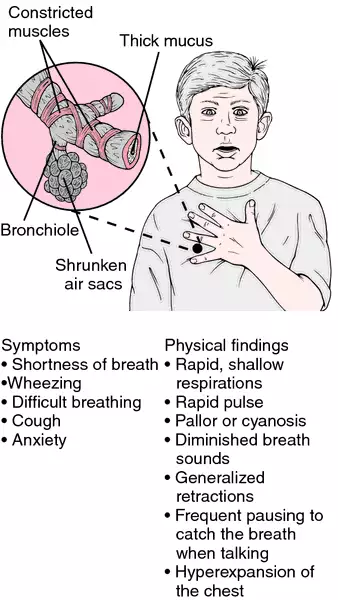 Source: medical-dictionary.thefreedictionary.com
Source: medical-dictionary.thefreedictionary.com
Chronic asthma develops due to the changes that occur from prolonged inflammation over time. Acute symptoms of asthma usually arise from bronchospasm and require and respond to bronchodilator therapy. 19 It is possible however for extrinsic asthma to become chronic in some individuals. Asthma is a common chronic disorder of the airways that involves a complex interaction of airflow obstruction bronchial hyperresponsiveness and an underlying inflammation. The infant is susceptible to a material that is foreign to the organism mast cells in his or her respiratory tract.
 Source: differencebetween.net
Source: differencebetween.net
Asthma is a chronic condition with periods of acute exacerbation. The exacerbations are mostly caused by an exposure to an allergen. Pathophysiology of Asthma Asthma is quite a complex condition in fact there are many different inflammatory structures cells and mediators that play together to create the symptoms. It begins in infancy. Pathophysiology of acute asthma exacerbation Asthma exacerbations include episodes of asthmatic attacks that are marked by worsening of asthmatic signs including chest tightness shortness of breath and wheezing.

This appears to be more common when asthma originally. It directly effects your breathing and leaves you short of breath. It is also called allergic asthma and is the most common form of asthma. Definitions and pathophysiology FIGURE 1. On ex - posure to a trigger excessive re -.
 Source: jacionline.org
Source: jacionline.org
It may arise after exposure and re - sponse to a specific allergen such as dust mites grass or tree pollen pet dander smoke or certain drugs or foods. It may arise after exposure and re - sponse to a specific allergen such as dust mites grass or tree pollen pet dander smoke or certain drugs or foods. Definitions and pathophysiology FIGURE 1. Chronic asthma develops due to the changes that occur from prolonged inflammation over time. On ex - posure to a trigger excessive re -.

There is a confluence of histopatholog-ical changes seen from the gene-environment interactions resulting in a. Acute asthma known as an asthma attack is an episodic event that occurs due to an asthma trigger. What is the pathophysiology. It is a commonly encountered problem across many care settings. Type 1 hypersensitivity reaction d.
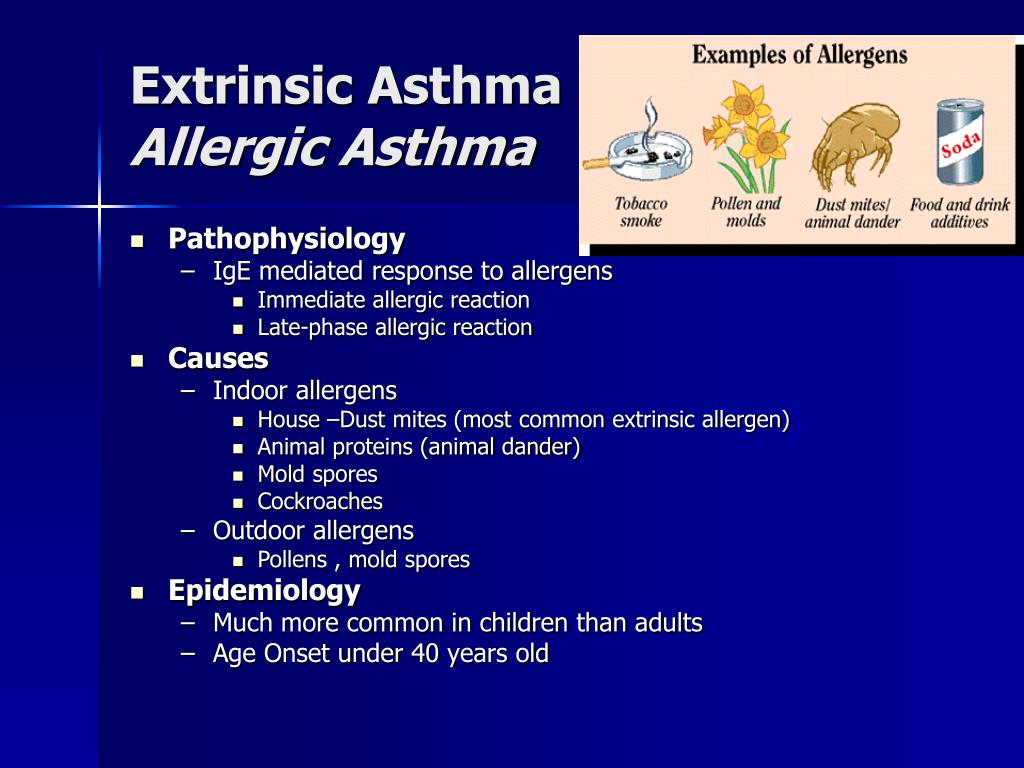 Source: slideserve.com
Source: slideserve.com
It is also called allergic asthma and is the most common form of asthma. During an asthma attack the airway gets inflamed and restricts the airflow to the lungs. Intrinsic asthma has a. There is a confluence of histopatholog-ical changes seen from the gene-environment interactions resulting in a. The exacerbations are mostly caused by an exposure to an allergen.
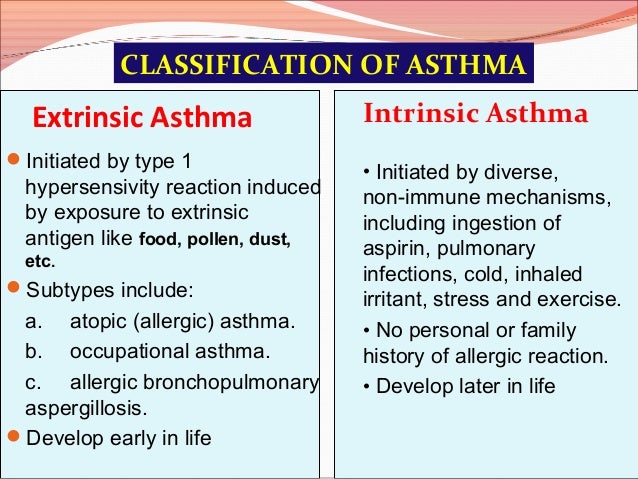 Source: slideshare.net
Source: slideshare.net
Atopic asthma begins in child - hood and is linked to triggers that initiate wheezing. Airway inflammation and hyper-responsiveness are associated with a number of different pre-disposing factors and attacks are often triggered by specific agents. What is the pathophysiology of an acute attack of extrinsic and intrinsic Asthma. It may be acute sub-acute or chronic which also causes intermittent airflow obstruction and bronchial hyper-responsiveness. The infant is susceptible to a material that is foreign to the organism mast cells in his or her respiratory tract.
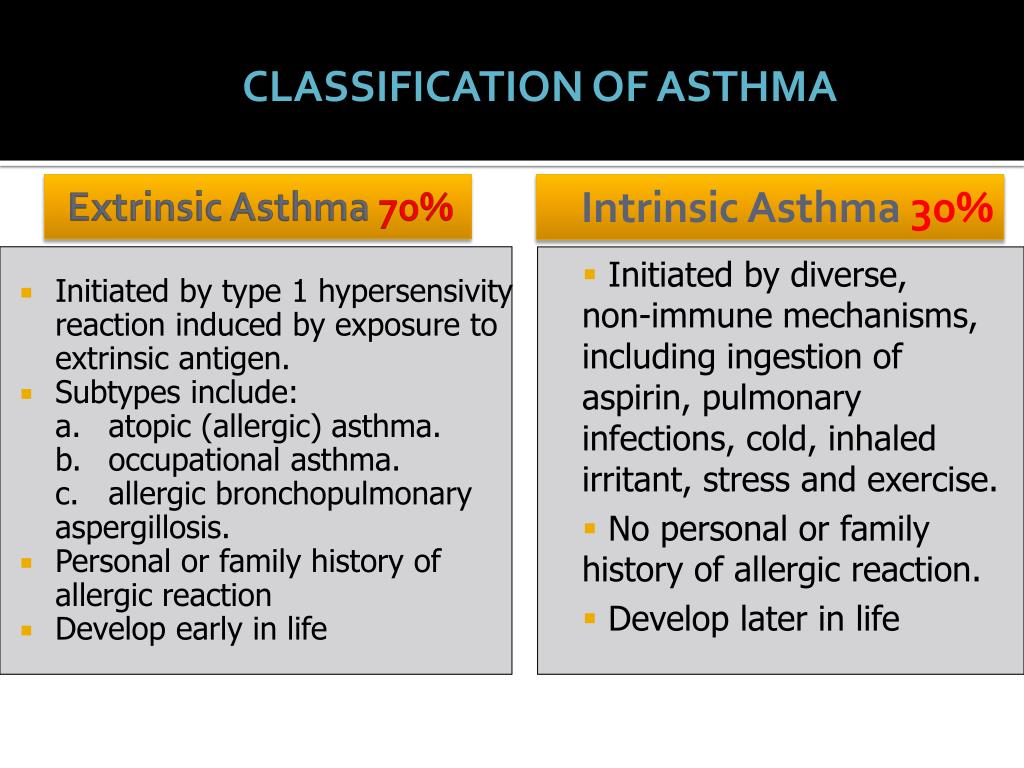 Source: slideserve.com
Source: slideserve.com
The exacerbations are mostly caused by an exposure to an allergen. There is a confluence of histopatholog-ical changes seen from the gene-environment interactions resulting in a. The infant is susceptible to a material that is foreign to the organism mast cells in his or her respiratory tract. It begins in infancy. This appears to be more common when asthma originally.
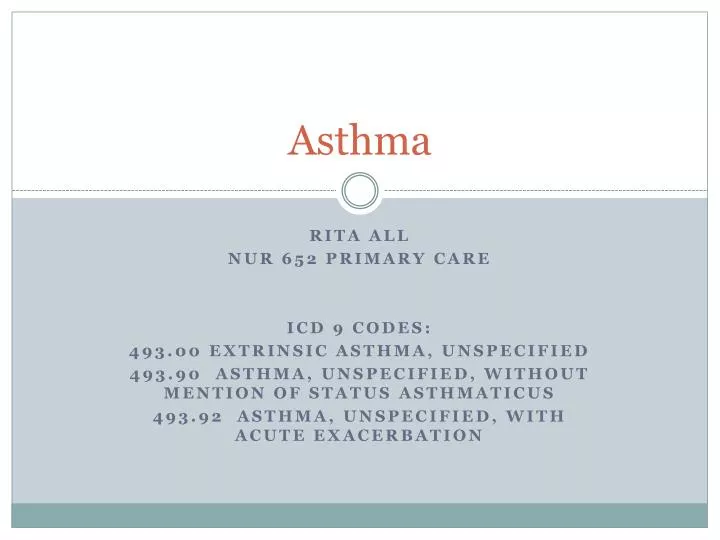 Source: slideserve.com
Source: slideserve.com
It is also called allergic asthma and is the most common form of asthma. Airway inflammation and hyper-responsiveness are associated with a number of different pre-disposing factors and attacks are often triggered by specific agents. Pathophysiology of Asthma Asthma is quite a complex condition in fact there are many different inflammatory structures cells and mediators that play together to create the symptoms. This interaction can be highly variable among patients and within patients over time. It is also called allergic asthma and is the most common form of asthma.
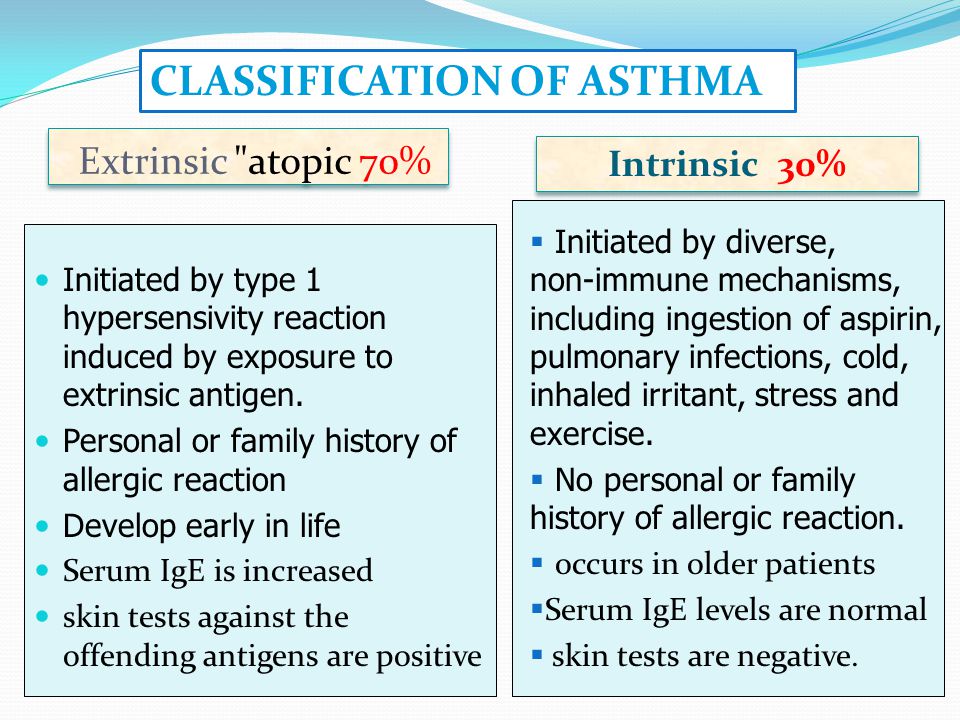 Source: slideplayer.com
Source: slideplayer.com
What is the pathophysiology of an acute attack of extrinsic asthma. This section presents a definition of asthma a description of the processes on which that definition is basedthe pathophysiology and. Acute symptoms of asthma usually arise from bronchospasm and require and respond to bronchodilator therapy. During an asthma attack the airway gets inflamed and restricts the airflow to the lungs. Classifying asthma Asthma may be atopic nonatopic or a combination.
 Source: schoolworkhelper.net
Source: schoolworkhelper.net
Type 1 hypersensitivity reaction d. Asthma takes place in two forms. During an asthma attack the airway gets inflamed and restricts the airflow to the lungs. Asthma is the presence of underlying airway inflammation which is variable and has distinct but overlapping patterns that reflect different aspects of the disease such as intermittent versus persistent or acute versus chronic manifestations. This interaction can be highly variable among patients and within patients over time.
 Source: slideplayer.com
Source: slideplayer.com
Intrinsic asthma has a. What is the pathophysiology of an acute attack of extrinsic asthma. This appears to be more common when asthma originally. Approximately 50 of asthmatic children become asymptomatic before reaching adulthood. This section presents a definition of asthma a description of the processes on which that definition is basedthe pathophysiology and.
 Source: clinicalgate.com
Source: clinicalgate.com
Classifying asthma Asthma may be atopic nonatopic or a combination. Pathophysiology of Asthma is a chronic disease that involves inflammation of passage airway. Gradual degeneration and fibrosis b. It directly effects your breathing and leaves you short of breath. What is the pathophysiology of an acute attack of extrinsic and intrinsic Asthma.
 Source: slidetodoc.com
Source: slidetodoc.com
What is the pathophysiology of an acute attack of extrinsic asthma. There is a confluence of histopatholog-ical changes seen from the gene-environment interactions resulting in a. Asthma is the presence of underlying airway inflammation which is variable and has distinct but overlapping patterns that reflect different aspects of the disease such as intermittent versus persistent or acute versus chronic manifestations. Pathology and Pathophysiology of Asthma. Approximately 50 of asthmatic children become asymptomatic before reaching adulthood.
This site is an open community for users to submit their favorite wallpapers on the internet, all images or pictures in this website are for personal wallpaper use only, it is stricly prohibited to use this wallpaper for commercial purposes, if you are the author and find this image is shared without your permission, please kindly raise a DMCA report to Us.
If you find this site adventageous, please support us by sharing this posts to your favorite social media accounts like Facebook, Instagram and so on or you can also bookmark this blog page with the title what is the pathophysiology of an acute attack of extrinsic asthma by using Ctrl + D for devices a laptop with a Windows operating system or Command + D for laptops with an Apple operating system. If you use a smartphone, you can also use the drawer menu of the browser you are using. Whether it’s a Windows, Mac, iOS or Android operating system, you will still be able to bookmark this website.





